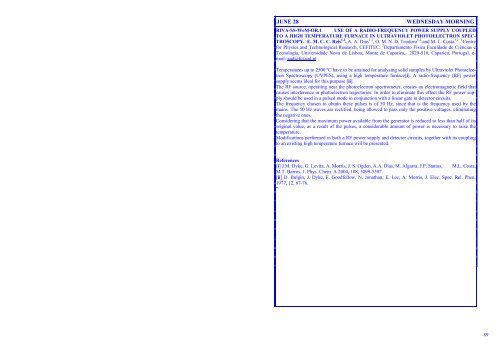Wüest M. 51 Wykes M. 82 Yamaguchi M. 17 Ybarra G. 129 Yubero F ...
Wüest M. 51 Wykes M. 82 Yamaguchi M. 17 Ybarra G. 129 Yubero F ...
Wüest M. 51 Wykes M. 82 Yamaguchi M. 17 Ybarra G. 129 Yubero F ...
Create successful ePaper yourself
Turn your PDF publications into a flip-book with our unique Google optimized e-Paper software.
JUNE 28 WEDNESDAY MORNING<br />
RIVA-SS-WeM-OR.1 USE OF A RADIO-FREQUENCY POWER SUPPLY COUPLED<br />
TO A HIGH TEMPERATURE FURNACE IN ULTRAVIOLET PHOTOELECTRON SPEC-<br />
TROSCOPY. E. M. C. C. Reis 1,2 , A. A. Dias 1,2 , O. M. N. D. Teodoro 1,2 and M. L. Costa 1,2 . 1 Centre<br />
for Physics and Technological Research, CEFITEC. 2 Departamento Física Faculdade de Ciências e<br />
Tecnologia, Universidade Nova de Lisboa, Monte de Caparica, 2<strong>82</strong>9-<strong>51</strong>6, Caparica, Portugal. e-<br />
mail: aad@fct.unl.pt<br />
Temperatures up to 2500 ºC have to be attained for analysing solid samples by Ultraviolet Photoelectron<br />
Spectroscopy (UVPES), using a high temperature furnace[i]. A radio-frequency (RF) power<br />
supply seems ideal for this purpose [ii].<br />
The RF source, operating near the photoelectron spectrometer, creates an electromagnetic field that<br />
causes interference in photoelectron trajectories. In order to eliminate this effect the RF power supply<br />
should be used in a pulsed mode in conjunction with a linear gate in detector circuits.<br />
The frequency chosen to obtain these pulses is of 50 Hz, since that is the frequency used by the<br />
mains. The 50 Hz waves are rectified, being allowed to pass only the positive voltages, eliminating<br />
the negative ones.<br />
Considering that the maximum power available from the generator is reduced to less than half of its<br />
original value, as a result of the pulses, a considerable amount of power is necessary to raise the<br />
temperature.<br />
Modifications performed in both a RF power supply and detector circuits, together with its coupling<br />
to an existing high temperature furnace will be presented.<br />
References<br />
[i] J.M. Dyke, G. Levita, A. Morris, J. S. Ogden, A.A. Dias, M. Algarra, J.P. Santos, M.L. Costa,<br />
M.T. Barros, J. Phys. Chem. A 2004, 108, 5299-5307.<br />
[ii] D. Bulgin, J. Dyke, F. Goodfellow, N. Jonathan, E. Lee, A. Morris, J. Elec. Spec. Rel. Phen.<br />
1977, 12, 67-76.<br />
“<br />
89
















